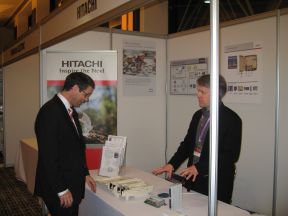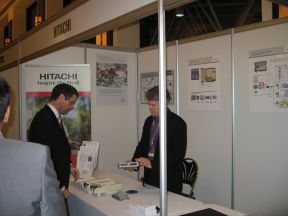(Way back in 2004, I ambitiously started a blog called Telecommedy with the intention of writing on it every day. I stopped writing there in 2005. C'est la guerre. In the interest of posterity and hubris, I am slowly moving those posts over here so that all of this inanity can be concentrated in a single forum and not pollute the intenets any more than necessary.)
Late at night, sitting in the system test lab, the conversations reach a philosophical level rarely seen since the days of the Algonquin round table. Hour upon hour spent contemplating red and green LEDs and flickering computer monitors (hey, adjust that refresh rate, you goober!) can lead to some of the deepest, most introspective exchanges that seem to make enormous sense at the time but are usually best left alone by the light of day.
We take you back to another time and place, where three lowly technicians are sitting in a dimly lit lab somewhere in Silicon Valley while the all-important Release 1.0 hardware and software are being put through a series of tests to ensure that they will not burst into flames after a few hours of continuous operation. We will call our laborators A.J., G., and Johnny. Those aren't their real names, of course. The names are changed to protect the innocent (currently typing these words) from the surly.
A.J.: Dude, are you sure you've got that set up right.
G.: Yea, I'm sure. I followed the directions exactly. See - the lights are all green.
A.J.: OK. Just checking. Hey, you guys seen "28 Days Later" yet?
Johnny: Yea, right. I have kids. The last movie I saw was "Finding Nemo".
G.: I hear ya. I don't even see TV anymore unless it's animated. We're into "Caillou" now.
Johnny: Oh yeah. We've got the Caillou thing going, too. Plus "Thomas" and "Jay Jay".
A.J.: OK, what are Thomas and Jay Jay. Sounds like Swedish porn.
*silence. count to three.*
Johnny: Thomas and his friends are trains with faces that have inane little stories with morals. The faces don't move, except for the eyes. And sometimes they clip different faces onto the trains to make them change expression. Happy face, sad face, excited face. Like that. The kids really love it.
G.: And there's about a million little toys that you have to buy to go along with it. Little trains and tracks...
Johnny: You have the Thomas Table yet?
G.: Yea, we got that one last birthday. It's covered in broken track right now. I found my wallet buried under it last week.
A.J.: Dudes, you guys are scaring me.
Johnny: Now for really scary, you have to see "Jay Jay the Jet Plane". It's the same idea as Thomas, but with airplanes. And it's animated so the faces move. Computer animation, so it looks 3D. The planes are just freaky.
G.: Not as many toys, though.
Johnny: Sometimes when I watch the airplanes with the kids, I start imagining alternate endings. Like, you know the one with the butterfly that's Jay Jay's friend?
A.J.: No.
G.: Yeah
Johnny: Have you ever wondered why the butterfly doesn't get sucked into the jet engines?
*silence. count to four*
Johnny: Seriously, even if the one butterfly doesn't get sucked in, the plane ends up following him to the hideout where thousands of butterflies live. There's no way he could take off without incinerating a few hundred. At the very least, I wanted to see him get back home with a few squished bugs stuck on the windshield.
A.J.: Dude, you need to get out more.
G.: Well, I have wondered if Savannah and Big Jake ever get it on.
A.J.: OK, now it's definitely porn. What are Savannah and Big Jake?
Johnny: Savannah's a fast plane with a bad southern accent. Big Jake's a big cargo plane. And no, that's one I hadn't thought of now. But thank you so much for the mental image. I'll be sharing that one with a therapist next week.
G.: Seriously. There are kid planes and adult planes. Obviously the kid planes have to grow up sometime. And they have to some from somewhere. Even planes have needs.
A.J.: Your brain is really starting to go there, G-Man. Planes have needs?
G.: You gotta make the shows interesting somehow. Like imagining hunters bagging Barney in the middle of a show and stuffing him and putting him in a museum next to the other dinosaurs. Stuff like that.
A.J.: Your wife know you've got this defect, man?
G.: Yeah, like I'm dumb enough to tell her about that.
Johnny: We need to come up with something like those shows. You know, the woman that's running the "Thomas" gravy train is a multi-millionaire? There's gotta be another one of those out there just waiting to be thought up. Like something in telecom. Talking telephones or something.
A.J.: Dude, even people in this business don't think it's that interesting. How about talking race cars? Kids love race cars, right? Or power tools. Or maybe rodents. You know, families of squirrels looking for nuts. You could sell stuffed squirrels and bags of nuts.
G.: I think those are all covered already. How about talking computers? It would be educational - teach the kids how to use a computer and stuff. Plus there'd be a family of peripherals.
Johnny: Like Mickey, the Mouse.
G.: Exactly! No wait ... very funny.
Johnny: They've gotta have wheels or something. Kids want to move them around. I like the race cars.
A.J.: Yea, there's hundreds of different car types. They could sit in the garage and talk. And there could be a mechanic that takes care of them and teaches them stuff like that Brenda Blue chick.
*pause for effect*
Johnny: Um, A.J., how do you know about Brenda Blue.
A.J.: Ah, you talked about her. With the airplanes.
G.: No, we didn't. We didn't mention her at all.
Johnny: You watch kids shows! What else? Sesame Street?! Oh, this is going to be fun for a long time in so many ways.
A.J.: No .. but .. I .... OK, maybe I watched it once ...
Johnny: Hey, G. Aren't we supposed to be recording this test?
G.: Yea, why?
Johnny: Isn't that computer supposed to be on or something.
*silence. count to ten.*
G.: Crap.
Labels: creations, humor, telecommunications



